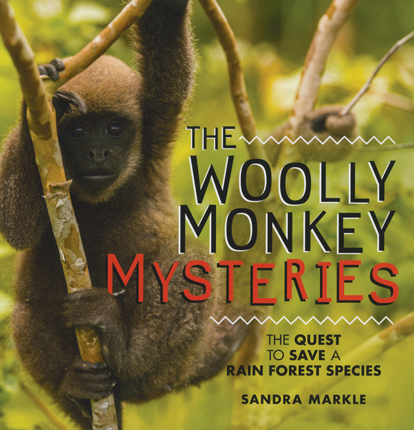| Woolly monkey mysteries : the quest to save a rain forest species (Sandra Markle's science discoveries) Author: Markle, Sandra | ||
| Price: $32.88 | ||
Summary:
Learn about how scientists use different methods of observation and incorporate technology to learn how to save this keystone species and protect the rain forests.
| Accelerated Reader Information: Interest Level: MG Reading Level: 6.50 Points: 1.0 Quiz: 501421 | Reading Counts Information: Interest Level: 3-5 Reading Level: 11.60 Points: 4.0 Quiz: 76689 | |
Reviews:
Kirkus Reviews (+) (01/01/19)
School Library Journal (02/01/19)
Booklist (02/15/19)
Full Text Reviews:
Booklist - 02/15/2019 Covered with dense, short fur that begs for a pat, the woolly monkey of South and Central America is, sadly, critically endangered. These rain- and cloud-forest dwellers are a challenge to study, as they live high in the forests’ canopies, but Markle introduces a few of the determined scientists monitoring these elusive creatures in Peru’s Manú Biosphere Reserve and National Park. Chief among them is Andrew Whitworth, whose Tree Top Manú Project has installed more than 100 motion-activated cameras in the forest’s trees to document woolly monkey activity. Woolly monkeys are considered a keystone species because they spread so many seeds around forests via their droppings—it’s estimated they poop up to 15 times per day! Photos of the monkeys and scientists at work dominate almost every page, with an accompanying text box that often contains quotes by the scientists. A labeled two-page spread depicts the four layers of a rain forest, while two QR codes link to videos by the CREES Foundation that show the primates in action. An interesting snapshot of modern biologists and their subjects. - Copyright 2019 Booklist.
School Library Journal - 02/01/2019 Gr 3–5—Readers follow scientists on their quest to learn more about the woolly monkey, a species that is vital to keeping the trees of South and Central America's rain forests just as they are—a home for plants and animals found nowhere else in the world. Clear, engaging graphics including maps, a description and illustration of the various layers of the rain forest, close-up photographs of researchers, and images of the monkeys, draw in readers. To study the monkeys in their natural surroundings, scientists use camera traps that are triggered by movement to take full-color photos or record short videos. As a result, scientists have learned about the crucial role of woolly monkeys in maintaining the rain forest. Markle's excitement at these findings is palpable and contagious. VERDICT An excellent choice to enhance science programs for upper elementary schoolers. Pair this book with Melissa Stewart's No Monkeys, No Chocolate to see how rain forest monkeys are essential to the production of chocolate.—Myra Zarnowski, City University of New York - Copyright 2019 Publishers Weekly, Library Journal and/or School Library Journal used with permission.



